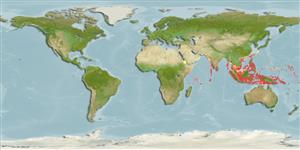Teleostei (teleosts) >
Ovalentaria/misc (Various families in series Ovalentaria) >
Pseudochromidae (Dottybacks) > Pseudochrominae
Etymology: Pseudochromis: Greek, pseudes = false + Greek, chromis = a fish, perhaps a perch (Ref. 45335).
More on author: Bleeker.
Environment: milieu / climate zone / depth range / distribution range
Ecology
Marine; reef-associated; depth range 2 - 60 m (Ref. 9710). Tropical; 30°N - 11°S
Indo-West Pacific: western coast of Australia (Ref. 7300) to New Caledonia (Ref. 11897), north to Japan (Ref. 559). Reported from the Laccadive Sea in India (Ref. 45255).
Size / Weight / Age
Maturity: Lm ? range ? - ? cm
Max length : 7.4 cm TL male/unsexed; (Ref. 90102)
Inhabits inshore reefs; also tide pools and lagoons (Ref. 1602). Solitary or in pairs in crevices (Ref 90102).
Life cycle and mating behavior
Maturity | Reproduction | Spawning | Eggs | Fecundity | Larvae
Paxton, J.R., D.F. Hoese, G.R. Allen and J.E. Hanley, 1989. Pisces. Petromyzontidae to Carangidae. Zoological Catalogue of Australia, Vol. 7. Australian Government Publishing Service, Canberra, 665 p. (Ref. 7300)
IUCN Red List Status (Ref. 130435)
Threat to humans
Harmless
Human uses
More information
Common namesSynonymsMetabolismPredatorsEcotoxicologyReproductionMaturitySpawningSpawning aggregationFecundityEggsEgg development
ReferencesAquacultureAquaculture profileStrainsGeneticsElectrophoresesHeritabilityDiseasesProcessingNutrientsMass conversion
Tools
Special reports
Download XML
Internet sources
Estimates based on models
Preferred temperature (Ref.
123201): 26.5 - 29, mean 28.3 °C (based on 444 cells).
Phylogenetic diversity index (Ref.
82804): PD
50 = 0.5000 [Uniqueness, from 0.5 = low to 2.0 = high].
Bayesian length-weight: a=0.00490 (0.00187 - 0.01281), b=3.11 (2.88 - 3.34), in cm total length, based on LWR estimates for this (Sub)family-body shape (Ref.
93245).
Trophic level (Ref.
69278): 3.3 ±0.2 se; based on diet studies.
Fishing Vulnerability (Ref.
59153): Low vulnerability (10 of 100).
Nutrients (Ref.
124155): Calcium = 168 [84, 275] mg/100g; Iron = 0.867 [0.511, 1.463] mg/100g; Protein = 18.3 [17.2, 19.3] %; Omega3 = 0.116 [0.065, 0.206] g/100g; Selenium = 29.3 [13.4, 64.0] μg/100g; VitaminA = 137 [43, 426] μg/100g; Zinc = 2.15 [1.40, 3.07] mg/100g (wet weight);
